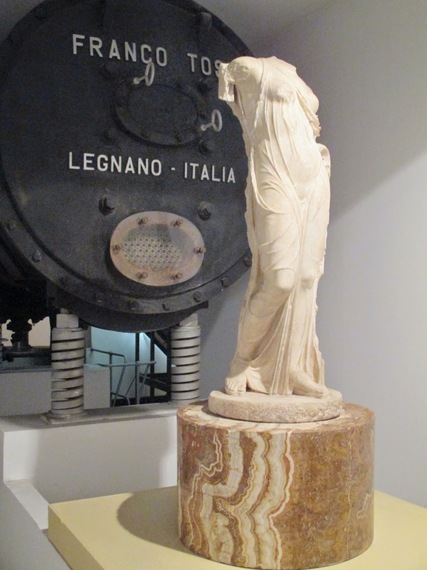
Italians are known for stylishness and design, but when you visit the Musei Capitolini Centrale Montemartini off the Via Ostiense, you can see just how far and how deeply the roots of the impulse go. Starting with 1870 and the capture of Rome, which was the final stage of the Risorgimento, Italian unification expressed itself culturally, political, and economically in the development of Rome as an important industrial center. The Giovanni Montemartini Thermoelectric Centre, where the Musei Capitolini Centrale Montemartini now stands, didn't just serve the quotidian purpose of providing electricity, but it's monumental structure was an expression of the turn of the century Italian futurist project with its millenarian nationalistic and even fascistic impulses. The plant has none of the characteristics of an American industrial utility of the same era. Sunlight floods huge windows. Inside are belle époque sconces and even the turbines themselves seem to have been designed with the concern for shape and design that might go into a Georgio Armani suit. In l997, the Musei Capitolini, seeking a additional repository for its huge collection, took over the abandoned structure. Now the visitor to the museum is greeted by a statue of Aphrodite in front of a turbine marked Franco Tosi Legnano-Italia. Throughout the museum turbines serve as a counterpoint to archeological finds. In its first incarnation the Musei Capitolini Centrale Montemartini represented a unique aestheticization of industrialization. Now in a new spin, the spirit of art of art represents another kind of energy. Former factory districts in New York like Soho and Long Island City (which houses MoMa PS1) have long become gentrified by artists who enjoy the solidity and spaciousness of old cast iron buildings and then there are London's Tate Modern and Paris's Musee d'Orsay whose buildings were respectively power and train stations. But in the case of the Musei Capitolini art and industry are uniquely conjoined to the extent that the idealizations of classical antiquity itself were a source of inspiration for the neo-classical structure in which it currently resides (viz. Guggenheim Museum, "Chaos & Classicism: Art in France, Italy and Germany, l918-1936").
photograph by Hallie Cohen
{This was originally posted to The Screaming Pope, Francis Levy's blog of rants and reactions to contemporary politics, art and politics}